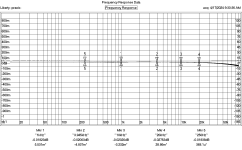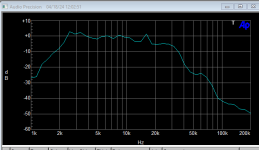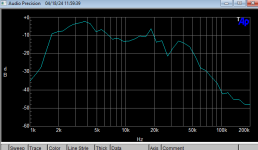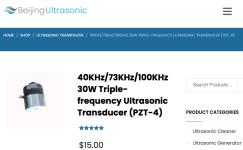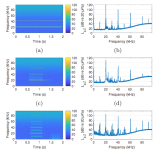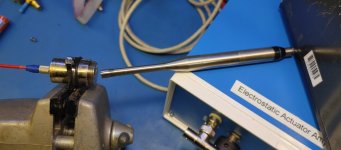The limiting factor seems to be the class D amplifier.
Plenty of audio interfaces and class A/B amps make it past 50Khz…
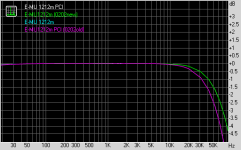
Reference:
https://www.ixbt.com/proaudio/emu-1212m-pci-pro.shtml
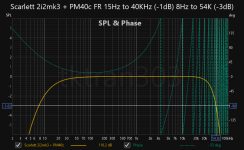
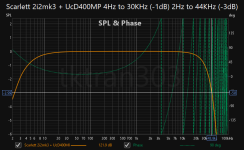
Plenty of audio interfaces and class A/B amps make it past 50Khz…

Reference:
https://www.ixbt.com/proaudio/emu-1212m-pci-pro.shtml


50kHz yes. 70kHz a lot less.Plenty of audio interfaces and class A/B amps make it past 50Khz…
Also, that is at -3dB so for a freq resp you have to correct accordingly.
I agree @markbakk . Most of the time, it really doesn't.
Here's the same tweeter measured by 3 microphones: All microphones come with electronic compensation files from their respective manufacturers.
1 mic <1 week old, 1 mic <5 years old, 1 mic ~10 years old.
There are some minor difference in the top octave. This is not unusual.
Since I'm an amateur, I'd be more likely to trust the new one. But all are OK for personal use, and if I only had one mic, I would just tweak the speaker to taste.

What do the professionals here do? @IamJF @Boden @b_force ?others?
Would you send them off for recalibration if you had these deviations in the top octave?
Here's the same tweeters when I extended the measurements as far as I could go:

Here's the same tweeter measured by 3 microphones: All microphones come with electronic compensation files from their respective manufacturers.
1 mic <1 week old, 1 mic <5 years old, 1 mic ~10 years old.
There are some minor difference in the top octave. This is not unusual.
Since I'm an amateur, I'd be more likely to trust the new one. But all are OK for personal use, and if I only had one mic, I would just tweak the speaker to taste.
What do the professionals here do? @IamJF @Boden @b_force ?others?
Would you send them off for recalibration if you had these deviations in the top octave?
Here's the same tweeters when I extended the measurements as far as I could go:
No, but someone was saying to be able to measure 70kHz from a certain HF driver.Who cares, we’re not measuring amp oscillation here, are we?
That depends how much you care about it, lolWould you send them off for recalibration if you had these deviations in the top octave?
As long as you know there is some small discrepancy above 10kHz I personally wouldn't bother that much.
In the end tweaking is sometimes also done by ear anyway.
It's different if you just simply don't have any clue what's going on at all.
Especially with troubleshooting that becomes a guessing game, which in my opinion just really sucks especially in those moments you can't use another unknown variable.
That being said, from the 2nd picture, the resonance peak seems to be totally gone?
Do the lower harmonics still come trough (they should be)?
The M23 and M30 have useful measurement capability past 23KHz, even as far as 50KHz, albeit uncalibrated. I’ve had some correspondence re: this. Thank you William.
This is an undocumented feature of the Earthworks microphones.
With the Xref20, the resonance appears a little subdued. The lower harmonics do come through, so there’s a hint…
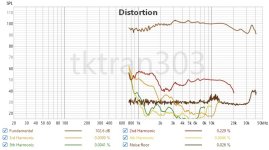
The 2nd picture is a measurement from the Umik-1, which is a USB enabled mic with an ancient 16bit/48KHz ADC, limiting the measurement to 24KHz. A Omnimic might also exhibit this, although I have not confirmed this. Without it may appears like there is no resonance (Umik-1, Omnimic)
This is a blind spot if measuring hard dome tweeter, which indeed is.
Ignorance is bliss.
This is an undocumented feature of the Earthworks microphones.
With the Xref20, the resonance appears a little subdued. The lower harmonics do come through, so there’s a hint…

The 2nd picture is a measurement from the Umik-1, which is a USB enabled mic with an ancient 16bit/48KHz ADC, limiting the measurement to 24KHz. A Omnimic might also exhibit this, although I have not confirmed this. Without it may appears like there is no resonance (Umik-1, Omnimic)
This is a blind spot if measuring hard dome tweeter, which indeed is.
Ignorance is bliss.
Last edited:
Hello All;
This subject interests me. Some years ago I built a plane wave tube. There was a thread called Poor mans Plane Wave Tube that discusses the building of this one and others.
When I started measuring on the PWT I had a pair of TEF04 mics and a pair of Earthworks M30’s.
I became interested in measuring compression driver distortion as part of my QC. I soon figured out that about 127dB SPL the mics flatline.
Just below that at 125dB my HD numbers were quite high. Remembering and re reading some of the old WE and Bell Labs stuff I was puzzled thinking to myself that these nice new JBL comp drivers wouldn’t pass QC in the 1930’s.
What I was seeing of course was mostly the distortion of my mics.
I bought a Larson Davis 910b mic pre and 2530 capsule and 2200C 200 Volt power supply that I think gets to 3% HD at 176 dB SPL.
JBL does their compression driver distortion measurements at 150dB SPL and now my measurements look just like theirs. This gives me some confidence that I am doing this right.
I would like to figure out the noise floor of some of my mics and preamps. I will have to read back and see if I can figure out how.
Thanks for all the shared information!
Barry.
This subject interests me. Some years ago I built a plane wave tube. There was a thread called Poor mans Plane Wave Tube that discusses the building of this one and others.
When I started measuring on the PWT I had a pair of TEF04 mics and a pair of Earthworks M30’s.
I became interested in measuring compression driver distortion as part of my QC. I soon figured out that about 127dB SPL the mics flatline.
Just below that at 125dB my HD numbers were quite high. Remembering and re reading some of the old WE and Bell Labs stuff I was puzzled thinking to myself that these nice new JBL comp drivers wouldn’t pass QC in the 1930’s.
What I was seeing of course was mostly the distortion of my mics.
I bought a Larson Davis 910b mic pre and 2530 capsule and 2200C 200 Volt power supply that I think gets to 3% HD at 176 dB SPL.
JBL does their compression driver distortion measurements at 150dB SPL and now my measurements look just like theirs. This gives me some confidence that I am doing this right.
I would like to figure out the noise floor of some of my mics and preamps. I will have to read back and see if I can figure out how.
Thanks for all the shared information!
Barry.
For preamp noise floor with condenser mikes a shielded cap of the same value as the capsule is the correct load. However I have encountered ceramic and mica caps that can be noisy with voltage across them. You may need to select the cap. I have these adapters from HP that have a cap inside and BNC to the 1/2" mike fitting. They will be hard to find. B&K has similar adapters but those work with the even harder to find B&K connections.
Mike capsule noise is probably more a physical phenomena than electrical. The B&K chart should give some baseline on what to expect. There are special ultra low noise B&K mike + preamp however you trade max SPL for sensitivity. The 1" is good to -5 dB A wtd SPL. Probably useful for Gnat farts. Here is the datasheet : https://www.bksv.com/media/doc/bp0389.pdf They lowered the tension on the diaphragm so it barely makes it to 15 KHz. Upper limit 103 dB for 3% THD.
Mike capsule noise is probably more a physical phenomena than electrical. The B&K chart should give some baseline on what to expect. There are special ultra low noise B&K mike + preamp however you trade max SPL for sensitivity. The 1" is good to -5 dB A wtd SPL. Probably useful for Gnat farts. Here is the datasheet : https://www.bksv.com/media/doc/bp0389.pdf They lowered the tension on the diaphragm so it barely makes it to 15 KHz. Upper limit 103 dB for 3% THD.
There is a lot in theis presentation on everything from basic calibration to High SPL and noise floor checking https://pearl-hifi.com/06_Lit_Archi...s/Basics_of_Acoustic_Cal_and_Measurements.pdf
I just remeasured the pioneer ribbon with different hardware- same mike. The horn smoothes the response however it also costs some HF lowering the corner from 45K? to 30K. Regardless this ribbon is not that useful above 40KHz. I need to find a transducer that is. I could reverse the 4136 if I had the right hardware and use it. But thats getting pretty crazy.
Pioneer has some tweeters that claim 100 KHz but I'm not spending $1K to find out.
Pioneer has some tweeters that claim 100 KHz but I'm not spending $1K to find out.
Attachments
I don't know what would be "useful" in your application, but transducers used for ultrasonic cleaning and welding are relatively cheap.Regardless this ribbon is not that useful above 40KHz. I need to find a transducer that is.
https://acta-acustica.edpsciences.org/articles/aacus/pdf/2020/04/aacus200008.pdf
Ultrasonic transducers also generate audible harmonics of the fundamental frequency, 20kHz in this example:
Brings back memories of Tom Danley's acoustic levitators, able to levitate styrofoam at about 150 dB, and lead ~165 dB, light a cigarette with acoustic friction ~ 175 dB SPL.
IIRC, Tom said a bug levitated seem to suffer no ill effects.
https://patentimages.storage.googleapis.com/f8/df/26/ffc206de39a069/US5036944.pdf
Be careful with ultrasonic frequencies, even though you can't hear them, they can still damage your hearing.
That said, can't blame Tom's 3 axis acoustic levitator for all my hearing loss
Art
Attachments
There is a lot in theis presentation on everything from basic calibration to High SPL and noise floor checking https://pearl-hifi.com/06_Lit_Archi...s/Basics_of_Acoustic_Cal_and_Measurements.pdf
Thank you very much 1audio!
119 pages of quality information. A good weekend study and hopefully some “doing”coming up.
I am very grateful.
Barry.
I would use the most reliable as reference - for me that would be a 1/4" mic (cause small membrane and still works close to "perfect" at 20kHz).View attachment 1300217
What do the professionals here do? @IamJF @Boden @b_force ?others?
Would you send them off for recalibration if you had these deviations in the top octave?
Blue one looks most realistic. What tweeter is that, reminds me to ScanSpeak Beryllium.Here's the same tweeters when I extended the measurements as far as I could go:
View attachment 1300228
Good sources for HF measurements are
a) T25B without grid, resonance at about 50kHz and pretty flat below.
b) A ring radiator, ScanSpeak with strong magnet keeps level best. These go down at high frequencies but have no resonances - so they are easy to compensate. High H2 of course and are beaming at high frequencies but can be used pretty high.
Blue one looks most realistic. What tweeter is that, reminds me to ScanSpeak Beryllium.
Good sources for HF measurements are
a) T25B without grid, resonance at about 50kHz and pretty flat below.
b) A ring radiator, ScanSpeak with strong magnet keeps level best. These go down at high frequencies but have no resonances - so they are easy to compensate. High H2 of course and are beaming at high frequencies but can be used pretty high.
This is an aluminium dome tweeter with optimized geometry.
Tweeter of B&W 685S2 speaker (introductory price £499/US$650 /pair in 2014)
@bwasloA Sony SS-CS5 speaker does a respectable job to near 80kHz as a source. Cheap, too.

This is several inches above the supertweeter axis (to avoid an interference cancellation)
Is your microphone calibrated to 80KHz?
With "prosumer" grade 2 channel ADC/DAC with balanced in/outs and phantom powered mic inputs, this what achievable for $120 in 2019:
In combination with a low power class A/B amp- Thomann PM40c's LM3886 based amplifier is good to about 50KHz (-3dB 54KHz).
Compare what happens when one is measuring up to 20KHz vs 50KHz.
Last edited:
The piezo suggestion finally clicked. I'm an inveterate collector of maybe useless stuff. In that collection is an Endevco high level piezo microphone (good to 180 dB SPL) (also mentioned in the B&K lit) https://buy.endevco.com/ContentStore/MktgContent/Endevco/Datasheet/2510M4A_DS_082019.pdf And being piezoelectric its also a transmitter. And it seems to go maybe past 150 KHz as a transmitter. That a region where I need to remove the grid on the B&K to get any meaning. A quick test was encouraging. I'll set up someting more formal soon.
Attachments
@bwaslo
Is your microphone calibrated to 80KHz?
Yes, quite recently by electrostatic actuator. I also have a 7016 microphone, also calibrated, and get essentially the same measurement.
With "prosumer" grade 2 channel ADC/DAC with balanced in/outs and phantom powered mic inputs, this what achievable for $120 in 2019:
In combination with a low power class A/B amp- Thomann PM40c's LM3886 based amplifier is good to about 50KHz (-3dB 54KHz).
But that scary plot is 1dB/div, all of 10dB down at 80kHz. The amplifier gain is falling but still usable well above there. That affects the measurement dynamic range, improved by coherent averaging, but not the ability to measure frequency responses. The signal path doesn't need to be flat, it only needs to be taken into account and be linear without compressing or aliasing.
The measurement was ratio metric, spectral content at the microphone divided by spectral content at the speaker terminals.
- Home
- Loudspeakers
- Multi-Way
- Distortion in Measurement Microphones - actual measurements
